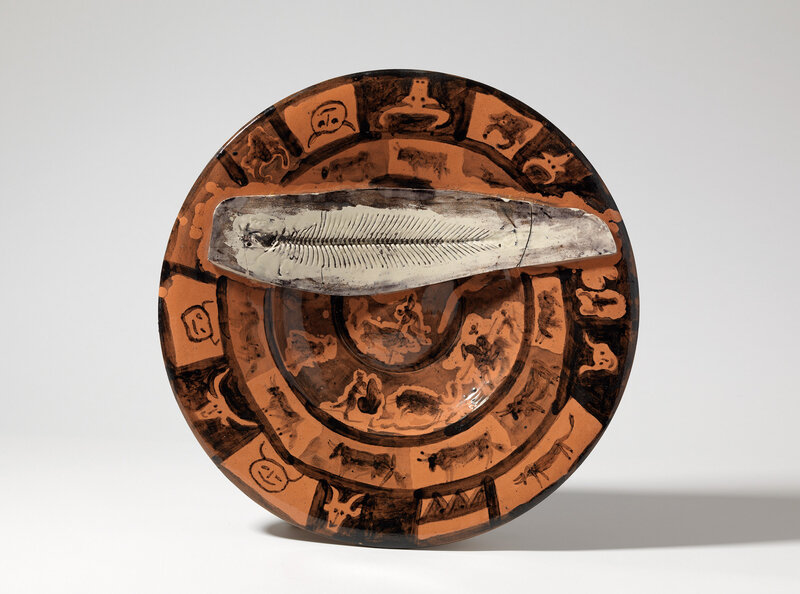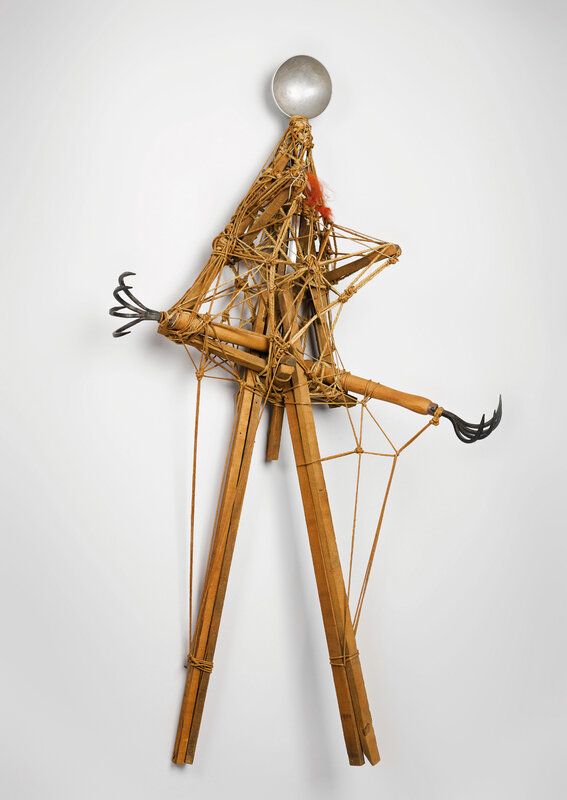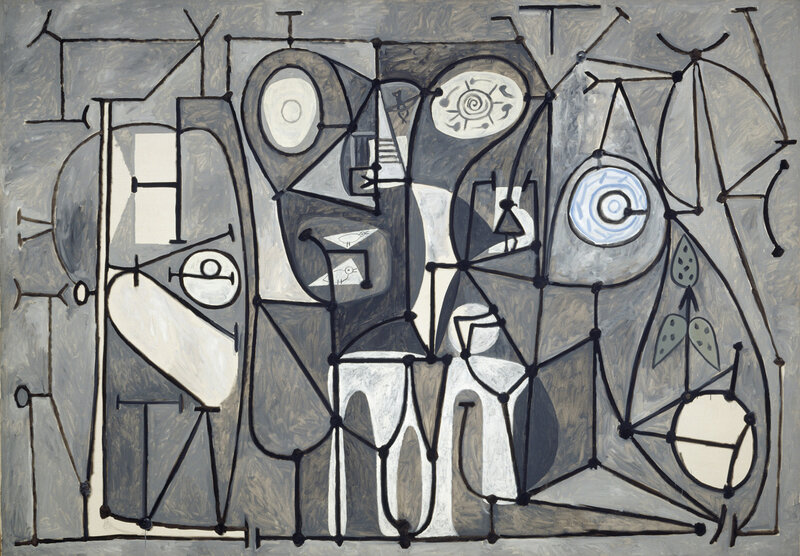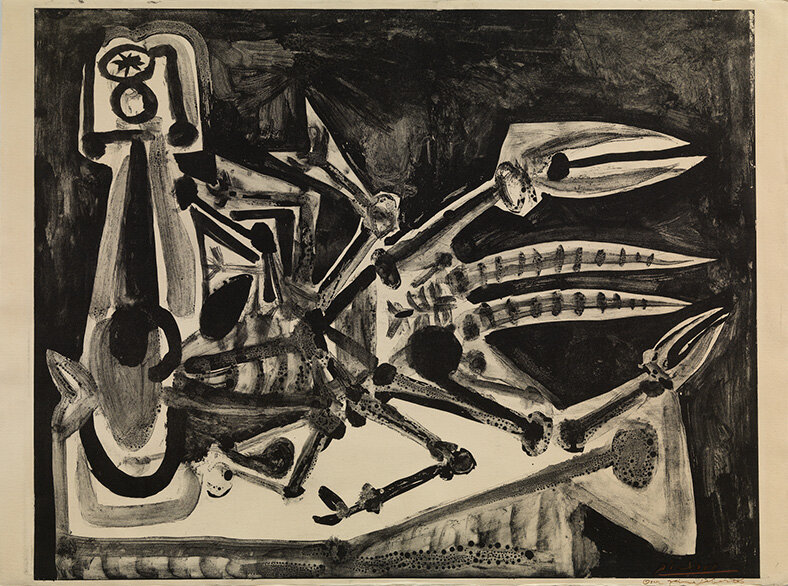Picasso's ties to the kitchen explored at Barcelona show
Pablo Picasso, Head of a Woman, Paris 1929–1930. Sculpture. Painted iron, sheet Metal, springs, and metal colanders, 39 3/8 × 14 9/16 × 23 1/4″ (100 × 37 × 59 cm). Musée national Picasso-Paris. Photo (C) RMN-Grand Palais (Musée national Picasso-Paris) / Mathieu Rabeau © Succession Pablo Picasso, VEGAP, Madrid 2018
BARCELONA (AFP).- A deformed bottle of wine, a colander in the place of a woman's head or a ceramic plate with inlaid fish bones: For the first time, the intimate connection between Pablo Picasso's work and gastronomy is on display in his Barcelona museum.
"It's a new vision of Picasso," Emmanuel Guigon, director of the Picasso Museum in the Mediterranean seaside city, told AFP at Wednesday's inauguration of the exhibition "Picasso's Kitchen."
"It seems weird but it isn't. Cooking is a theme that is in all Picasso's work and in all formats: paintings, sculptures, pottery and even poetry."
Strolling through the exhibition is like making one's way through a multi-course meal, with more than 180 works of art -- some of them borrowed from other museums or private collections -- scattered in 10 rooms.
Cherry on the cake -- one room has been designed by Spanish gastronomy's Picasso, molecular gastronomy chef Ferran Adria, who has imposed his vision of the creative process in the kitchen with diagrams and photos of his dishes.
Pablo Picasso, Menu for the Quatre Gats, Dish of the Day, c. 1900. Wax and ink on paper, 45.5 × 29 cm, The Hunt Museum, Limerick, MG145 © Succession Pablo Picasso, VEGAP, Madrid 2018
Adria, founder of the El Bulli restaurant which was voted world's best five times before closing in 2011, said Picasso and former FC Barcelona player and coach Johan Cruyff, one of football's most visionary figures who died in 2016, were his "two creative references".
"To be here is a dream, twenty years ago this would have been impossible," he said.
"But today in art there are people who are interested in what we are doing, an entire generation of chefs who want to be on the forefront."
"In a 100 years my dishes can't be shown in any museum," Adria joked.
"But to understand his system of creation and how he worked helps us to analyse and compare it to ours."
Ricard Opisso, Interior of the Quatre Gats, 1900. Charcoal, ink and pencil on paper, 41.9 × 49.1 cm, Arxiu Històric de la Ciutat de Barcelona, AHCB18162. © Succession Pablo Picasso, VEGAP, Barcelona 2018
'Metaphor of creation'
The exhibition, which will run until September 30, "is not a catalogue of ingredients...it is a metaphor of creation", of how an everyday objects becomes art or a memory, said the curator of the show, Androula Michel.
Everyday objects such as a bottle of wine, a roasted chicken or fish are depicted by Picasso as disfigured still lifes in his cubist style.
A colander represents the head of a woman in one sculpture while a painting of two leeks next to a skull depict the hard5ships in Paris during the Second World War.
Pablo Picasso, Head of a Woman, Paris 1929–1930. Sculpture. Painted iron, sheet Metal, springs, and metal colanders, 39 3/8 × 14 9/16 × 23 1/4″ (100 × 37 × 59 cm). Musée national Picasso-Paris. Photo (C) RMN-Grand Palais (Musée national Picasso-Paris) / Mathieu Rabeau © Succession Pablo Picasso, VEGAP, Madrid 2018
The exhibition has borrowed works from around 30 museums and private collections, including some of Picasso's most famous creations such as his 1914 sculpture "Glass of Absinthe" and his 1914 painting "Restaurant".
Pablo Picasso, Glass of Absinthe, París, primavera del 1914. Bronce pintado y cucharilla de absenta de plata, 21 × 14 × 7 cm. Fundación Almine y Bernard Ruiz-Picasso para el Arte, Madrid, 55158. FABA Photo: Eric Baudouin: © Succession Pablo Picasso, VEGAP, Madrid 2018
Pablo Picasso, The Restaurant, 1914. Oil on canvas, 34 × 42 cm, Fundación Almine y Bernard Ruiz-Picasso para el Arte, Madrid. On deposit at the Museo Picasso Málaga. FABA Photographe inconnu, tous droits réservés © Succession Pablo Picasso, VEGAP, Madrid 2018
Also on show is his "Bullfight and fish" ceramic plate in which Picasso incrusted the fish bones of a sole.
It is displayed alongside a photo taken by David Douglas Duncan of Picasso while he ate the fish in Cannes.
Pablo Picasso, Bullfight and Fish (verso: Faces), Cannes, [16 April] 1957. Thrown red earthenware with applied fish (white earthenware impressed with fish skeleton, transparent glaze, grey patina; cracked and repaired), decorated with patina and black oxide, partial brushed transparent glaze, 42 cm (diameter), Museu Picasso, Barcelona. Gift of Jacqueline Picasso, 1982, MPB 112.446. Photo: Museu Picasso, Barcelona. Photograph, Gasull Fotografia. © Succession Pablo Picasso, VEGAP, Madrid 2018
David Douglas Duncan, Picasso in La Californie making Bullfight and Fish (verso: Faces), Cannes, April 1957. Modern digital copy by inkjet, 50 x 60 cm, David Douglas Duncan’s Archive, Arxiu Museu Picasso de Barcelona, FDDD/9/84. Photo Arxiu Museu Picasso, Barcelona © Succession Pablo Picasso, VEGAP, Madrid 2018
The relationship between Picasso's work and the kitchen "is something obvious that has never been explored before," said Guigon.
"I hope people will enjoy this menu a great deal," he added. © Agence France-Presse
Pablo Picasso, Figure, 1935. Ladle, rakes, wood, string, nails and feather, 112 × 61.5 × 29.8 cm. Musée national Picasso-Paris. Gift by Pablo Picasso, 1979, MP316. Photo (C) RMN-Grand Palais (Musée national Picasso-Paris) / Adrien Didierjean / Mathieu Rabeau © Succession Pablo Picasso, VEGAP, Madrid 2018.
Pablo Picasso, Facsimile of Desire Caught by the Tail, Act 1, Scene 1, 1941. Ink on paper, 31 × 24 cm, Musée national Picasso-Paris. Photo (C) RMN-Grand Palais (Musée national Picasso-Paris) / MichèleBellot © Succession Pablo Picasso, VEGAP, Madrid 2018.
Pablo Picasso, Nen amb llagosta, 21 de juny del 1941. Oli sobre tela, , 130 x 97,3 cm. Photo (C) RMN-Grand Palais (Musée national Picasso-Paris) / Jean-Gilles Berizzi © Successió Pablo Picasso, VEGAP, Madrid 2018
Pablo Picasso, La cuina, Novembre del 1948. Oli sobre tela, 175 × 252 cm, Musée national Picasso-Paris. Donació de Pablo Picasso, 1979, MP 200. Photo (C) RMN-Grand Palais (Musée national Picasso-Paris) / Franck Raux © Successió Pablo Picasso, VEGAP, Madrid 2018.
Pablo Picasso, Still Life with Basket, Three Sea Urchins and a Lamp, October 19, 1946. Oleoresinous paint and charcoal on reused canvas, 35.5 × 85.5 cm, Musée Picasso, Antibes, MPA 1946. 1.9. ImageArt, photo Claude Germain © Succession Pablo Picasso, VEGAP, Madrid 2018.
Pablo Picasso, The Luncheon on the Grass after Manet, March 3–August 20, 1960. Oil on canvas, 130 × 195 cm, Musée national Picasso-Paris. Gift by Pablo Picasso, 1979, MP 215. Photo (C) RMN-Grand Palais (Musée national Picasso-Paris) / Jean-Gilles Berizzi © Succession Pablo Picasso, VEGAP, Madrid 2018
Pablo Picasso, The Lobster, 9 January 1949. Lithograph. Lithotint on zinc (Sabartés proof), 56.5 x 76 cm, Museu Picasso, Barcelona. Gift of Jaume Sabartés, 1962, MPB 70.104. Photo Museu Picasso, Barcelona. Photograph, Gasull Fotografia © Succession Pablo Picasso, VEGAP, Madrid 2018
Pablo Picasso, Still Life with a Glass by Lamplight, Mougins, March 19, 1962. Linocut done with a gouge (Sabartés proof, V and definitive state), 62 × 75 cm, Museu Picasso, Barcelona. Gift by Jaume Sabartés, 1964, MPB 70.322, Museu Picasso, Barcelona. Reproduccions fotogràfiques de Gasull Fotografia © Succession Pablo Picasso, VEGAP, Madrid 2018

/https%3A%2F%2Fprofilepics.canalblog.com%2Fprofilepics%2F1%2F0%2F100183.jpg)
/https%3A%2F%2Fstorage.canalblog.com%2F03%2F02%2F119589%2F96711876_o.jpg)
/https%3A%2F%2Fstorage.canalblog.com%2F11%2F31%2F119589%2F94773502_o.jpg)
/https%3A%2F%2Fstorage.canalblog.com%2F20%2F83%2F119589%2F94772815_o.jpg)
/https%3A%2F%2Fstorage.canalblog.com%2F26%2F72%2F119589%2F75604929_o.jpg)
/https%3A%2F%2Fstorage.canalblog.com%2F59%2F60%2F119589%2F26458628_o.jpg)


















/http%3A%2F%2Fstorage.canalblog.com%2F25%2F77%2F119589%2F129711337_o.jpg)
/http%3A%2F%2Fstorage.canalblog.com%2F60%2F34%2F119589%2F128961949_o.png)
/http%3A%2F%2Fstorage.canalblog.com%2F84%2F21%2F119589%2F128701730_o.jpg)
/http%3A%2F%2Fstorage.canalblog.com%2F96%2F14%2F119589%2F128351398_o.jpg)